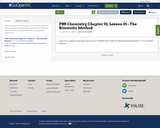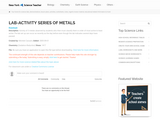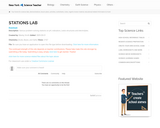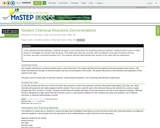
Students will visualize how combustion reactions occur and how the burning of fossil fuels produces CO2.
- Subject:
- Chemistry
- Earth Science
- Science
- Material Type:
- Lesson Plan
- Provider:
- NCDENR
- Author:
- NC Air Awareness Program
- Date Added:
- 02/26/2019

Students will visualize how combustion reactions occur and how the burning of fossil fuels produces CO2.

In this lesson students will build and visualize carbon-compounds using a "ball and stick" molecular model kit that includes carbon, hydrogen and oxygen atoms. This lesson also looks at photosynthesis, cellular respiration, biosynsthesis, combustion and hydrocarbons.

In this lab activity, students will react an acid and a metal to produce hydrogen gas and metal salt. They will then determine the amount of gas produced at room conditions and then use the combined gas law to prodeict how much gas would be produced at STP.

Students will model the single displacement/redox reaction of separating silicon from silicon dioxide.

In this lab activity, students will investigate a single replacement reaction while also determining mole ratios to determine percent yields.

In this lab activity, students will react magnesium with hydrochloric acid to produce hydrogen gas and collect data with a Vernier Gas Pressure sensor. The concepts of stoichiometry, ideal gas law, combined gas law, standard temperature and pressure, and the molar volume of a gas will all be used in this experiment.

Students practice writing various types of chemical equations.

This worksheet assesses student understanding of nuclear chemistry concepts and provides practice in writing nuclear equations.

Students will describe the steps of the scientific method as well as distinguish between observations and conclusions. Students will also identify quantitative and qualitative observations.

In this lesson, students will define physical property, chemical property, physical change, and chemical change. Students will also describe the phases of matter as well as labeling properties and changes as physical or chemical. Finally, students will be able to state the Law of Conservation of Mass.

In this lab activity, students use available materials and their knowledge of double replacement reactions and solubility to isolate an ionic compound.

In this activity, students will predict the outcome of chemical reactions based on balanced equations. They will combine calcium with water and confirm evidence of the reaction by testing for the presence of gas, then answer a series of questions based on their results.

Students will determine the relative reactivity of three metals: copper, magnesium, and zinc by using the activity series of metals.

Students rotate through a variety of stations in order to demonstrate understanding of the properties of acids, bases, and solutions.

In this lab activity, students are given a set of instructions for producing chemical reactions. Students work in pairs or small groups to investigate the reaction they are given. They determine what has occurred, what is produced, what type of reaction that has occurred, and write a chemical equation for it. The students will then demonstrate their reaction to the class with the explanation.

In this lesson, students will collect soil, water, and paint chip samples from their homes and use a qualitative precipitate laboratory to locate geographic lead hot spots, correlated with the historic construction of building episodes in their community. Associated with this lesson will be the construction of a word wall detailing the physiological effects of prolonged exposure to inorganic lead, culminating in a writing assignment outlining a fictional case study of a child afflicted with lead poisoning.